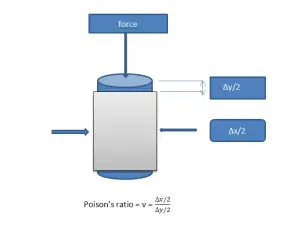Poison’s ratio is the ratio between lateral strains and longitudinal strains. Poisson’s ratio, mathematically can be given as:
\(V=frac{Lateral Strain}{Longitudnal Strain}\)V= – (lateral strain)/(longitudnal strain)
When compressive force acts on a specimen then with the increase in force, two types of strains that will crop in the specimen of concrete. Both strains are opposite in direction, one is along x-axis that we call as longitudinal strain and second is in vertical direction, that is produce due to reduction in volume(when compressive load acts on specimen). These strains are named as:
- Lateral strains/ vertical strains
- Longitudinal strains/ horizontal strains
Poisson’s ratio = v = (∆x/2)/(∆y/2)
Lateral Strains/ Vertical Strains
When load acts on concrete specimen, than aggregates that are smaller in size get crushed and powder is form. Now when more load acts, this powder is not able to resist the load and now lateral strains produce due to reduction in volume. Larger particles also get crushed with the application of load, but due to more density than smaller aggregates, these will crushed in later stages.
Longitudinal Strains/ Horizontal Strains
When compressive load acts on a concrete specimen then with the rise in load, specimen trying to expand, but friction between the specimen and platen (it is in between the specimen and load testing machine.
It is used while testing compressive strength of concrete) try to cancel this expansion. Up to the strength of concrete this friction cancels out horizontal strains, but as the applied load crosses the limit of strength. Strains start occurring in longitudinal direction.
Range Of Poisson’s Ratio (Poisson’s Ratio Limits)
Poisson’s ratio value varies with the type of specimen i. e whether dry, wet or saturated or how load will act on the specimen. Poison’s ratio in normal conditions varies from 0.15-0.2, but this value is continuously increasing or decreasing with the variations in loading conditions.
For static load conditions, poison’s ratio is smaller as compared to dynamic load where it is almost about 0.20-0.25.

